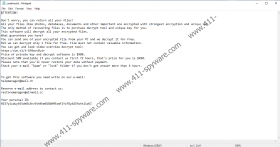Pykw Ransomware Removal Guide
When did Pykw Ransomware invade your Windows operating system? Perhaps you do not have an answer to this question, and we are sure that many victims of this threat will be in the same position. That is because this malware relies on stealth when invading systems. If a victim knew what was going on, they would, in theory, have a chance to remove it before anything bad happened. However, if the attackers are able to fool Windows users into opening malicious email attachments, executing malicious downloaders, or leaving RDP channels exposed, they might have the chance to drop the infection silently. What happens next? It is unlikely that this malware would wait long to encrypt files because the longer it waits the higher are the chances of it being discovered and eliminated. Without a doubt, you must delete Pykw Ransomware, but if you do that after encryption, your files will not be salvaged in the process.
We know how Pykw Ransomware works very well because it is pretty much identical to Kasp Ransomware, Boop Ransomware, Usam Ransomware, Odgo Ransomware, and other threats that are part of the STOP Ransomware group. These infections are built to corrupt files and also drop one single text file. That is all that they need to do, and that is not much at all. On the bright side, because this malware is so simple, deleting it is not the most complicated task in the world. Of course, victims with less experience might still face issues, and that is why we discuss alternative methods of removal in this post. But let’s discuss Pykw Ransomware first. When it invades the system, and if security software is not set up to catch and remove it quickly, it encrypts files. It adds the “.pykw” extension to them to help victims navigate. At the time of research, STOP Decryptor was the only third-party tool that could decrypt some of the files for free. The condition is that files have to be encrypted with an offline key.
If the victim cannot use a free decryptor successfully, and if backup copies do not exist (or do not exist for all important files), they might be convinced to purchase a decryptor from cybercriminals. Just like all clones, Pykw Ransomware uses “_readme.txt” to introduce victims to two email addresses: helpmanager@mail.ch and restoremanager@airmail.cc. The message within the text file suggests that if you send one encrypted file to either of these addresses within 72 hours, the attackers will decrypt it for free and will also provide you with information that you need to pay the ransom of $490. After 72 hours, the ransom, allegedly, would go up to $980. Even if you were asked to pay one penny, we would not recommend getting involved with cybercriminals. They want to connect to you via email so that they could extort money from you and, quite possibly, scam you in the future. They want you to believe that you can purchase a decryptor, because Pykw Ransomware was created to make money. Unfortunately, you are unlikely to obtain this decryptor.
So, how do you remove Pykw Ransomware? If you have experience with ransomware, and if you are able to analyze files to determine whether they belong to malware or not, follow the guide below. Note that one component is hidden within a folder with a random name, and its own name is random too. Please make sure you are removing the right components before you do it. If the task is just too complicated for you, employing anti-malware software is the right move. It will simultaneously delete Pykw Ransomware and also establish Windows protection to keep other threats away. Obviously, such software should have existed on your system a long time ago, because if it did, you would not be dealing with the ransomware right now. Another thing to fix is file backup. Employ virtual storage or an external drive, and always move copies of important files for safe keeping. This will ensure complete protection for your files just in case something happens with the original copies.
How to delete Pykw Ransomware
- Delete recently downloaded suspicious files.
- Launch File Explorer (tap Windows+E keys).
- Enter %LOCALAPPDATA% into the field at the top.
- Delete {random name} folder with {random name}.exe file inside.
- Enter %HOMEDRIVE% into the field at the top.
- Delete the ransom note file, _readme.txt.
- Delete the folder named SystemID with PersonalID.txt inside.
- Exit File Explorer and also Empty Recycle Bin.
- Employ a malware scanner to check for leftovers.
Pykw Ransomware Screenshots:


